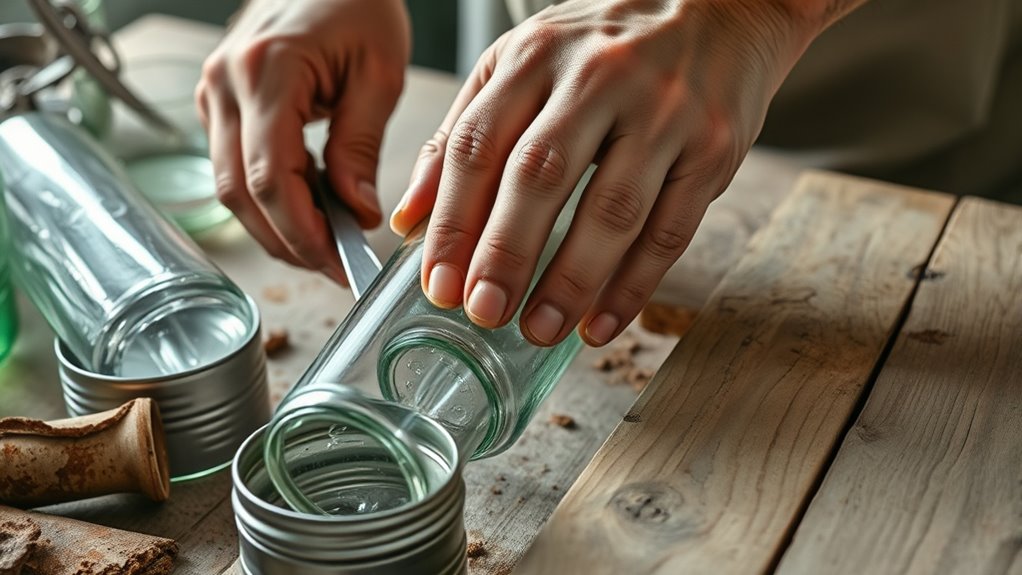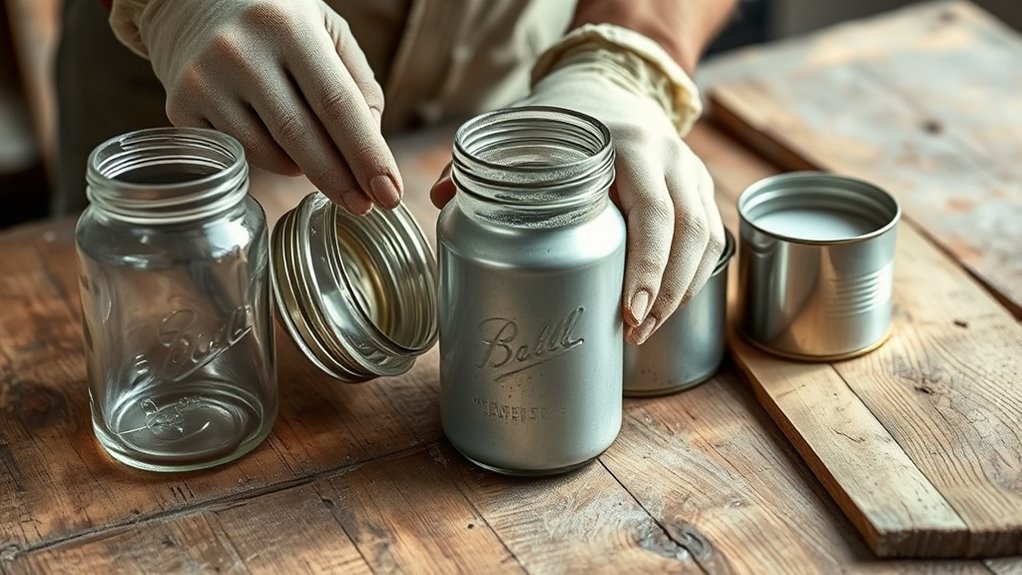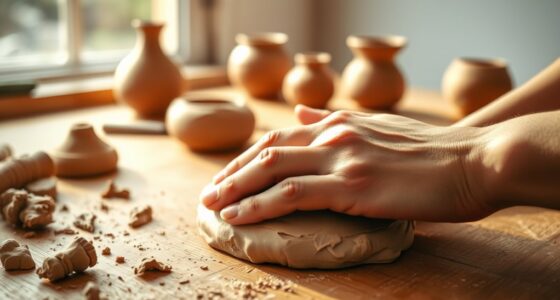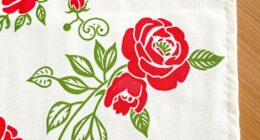To safely prepare glass, tin, and wood for upcycling, start by thoroughly cleaning and removing labels or adhesives. Use warm, soapy water for glass and rinse well; scrub off residue if needed. For wood, sand the surface to remove old paint or rough patches, ensuring it’s smooth and debris-free. Apply eco-friendly paints and primers for a durable finish. Keep safety in mind, work in ventilated areas, and dispose of leftover materials responsibly to get the best results for your project.
Key Takeaways
- Thoroughly clean glass bottles and jars by removing labels, adhesives, and rinsing with warm, soapy water.
- Sand wood surfaces to remove old paint or rough patches, ensuring a smooth, clean surface for new finishes.
- Use eco-friendly paints free from VOCs, applying primers for better adhesion and durability on glass, tin, and wood.
- Work in well-ventilated areas, wear protective gear, and dispose of leftover materials responsibly to ensure safety and environmental care.
- Soak or scrub tin cans to eliminate food residues and adhesives, preparing them for painting or decorative upcycling projects.

Have you ever wondered how you can turn waste into something valuable? Upcycling materials is a fantastic way to do just that, especially when you understand the proper steps to prep and transform glass, tin, and wood. It all starts with mastering the right recycling techniques, which guarantee that your materials are clean, safe, and ready for their new purpose. When working with glass, for example, you want to remove any labels or adhesives thoroughly. Wash the bottles or jars with warm, soapy water, then scrub away any remaining residue with a sponge or brush. For tin cans, it’s crucial to rinse out any food or liquids completely and remove labels. Sometimes, you might need to soak the cans to loosen stubborn adhesive. With wood, the prep process involves sanding off old paint, varnish, or any rough patches. Use a medium-grit sandpaper to smooth surfaces and remove splinters, making the wood safer and more receptive to new finishes. Additionally, choosing regional flavors and traditions can inspire creative color choices and designs for your upcycled pieces.
One of the most eco-friendly ways to give these materials a fresh look is by using eco friendly paints. These paints are free from harmful chemicals like volatile organic compounds (VOCs), making them safer for you and the environment. When painting glass or tin, consider applying a primer designed for non-porous surfaces to improve adhesion and durability. For wood, a primer helps seal the surface, preventing stains and ensuring the paint sticks evenly. After prepping and priming, choose eco friendly paints that match your style and project needs. For glass, transparent or tinted eco paints can turn a simple jar into a decorative vase or storage container. With tins, vibrant colors can transform cans into planters or art pieces. When working with wood, you have the flexibility to explore various finishes, from matte to glossy, all while ensuring the process stays eco-conscious.
It’s important to pay attention to safety during the prep and painting process. Work in well-ventilated areas, wear gloves, and use masks if you’re sanding or handling fumes from paints. Properly disposing of leftover paint and used materials is also part of responsible upcycling. Once you’ve finished the painting, allow your creations to cure fully before use, which guarantees longevity and safety. The combination of proper recycling techniques and eco friendly paints not only guarantees a safe and effective upcycling process but also contributes to reducing waste and protecting the environment. With patience and care, you can turn old, discarded items into beautiful, functional pieces that showcase your creativity and dedication to sustainability.
Frequently Asked Questions
How Do I Remove Labels Safely From Glass Containers?
To remove labels safely from glass containers, start by soaking them in warm water with a few drops of dish soap for about 10-15 minutes. This softens the adhesive, making label removal easier. Gently peel off the labels, using a plastic scraper if needed. For stubborn residue, apply a bit of rubbing alcohol or vinegar, then wipe clean. This effective label removal technique guarantees proper glass container preparation for your upcycling project.
What Are Eco-Friendly Methods to Strip Paint From Wood?
To gently refresh your wood, try eco-friendly peeling techniques like using a vinegar and baking soda solution, which softens paint naturally. Alternatively, explore eco-friendly paint stripper options such as citrus-based or soy-based strippers that are less harsh on the environment. These methods effectively strip paint while respecting nature, helping your project remain sustainable. With patience and care, you’ll reveal the beautiful wood beneath without compromising eco-conscious standards.
Can I Safely Upcycle Rusty Tin Cans?
Yes, you can safely upcycle rusty tin cans. Start with rust removal by soaking the cans in a vinegar solution or using a wire brush to scrub away rust. Then, perform paint stripping with eco-friendly methods like baking soda paste or citrus-based removers. After cleaning and rust removal, rinse thoroughly, dry completely, and prime the cans before painting or decorating. This guarantees a safe and eco-friendly upcycling process.
What Protective Gear Is Recommended for Woodworking Prep?
Think of your safety gear as your armor before diving into woodworking. You should wear protective gloves to shield your hands from splinters, sharp edges, and splashes. A dust mask is essential to prevent inhaling airborne particles and sawdust, especially during sanding or cutting. Together, these pieces of protective gear keep you safe, allowing you to focus on your project without worry. Always prioritize your safety first!
How Do I Ensure the Safety of Upcycled Materials for Indoor Use?
To guarantee the safety of your upcycled materials indoors, start with thorough safety inspections and material testing. Check for any cracks, splinters, or residues that might pose health risks. Test for toxins or old paints that could contain harmful chemicals. Clean and sand surfaces properly, and use non-toxic finishes. By doing these steps, you create a safe environment and reduce potential hazards from your upcycled projects.
Conclusion
So, now that you’re a master of upcycling, go ahead—give those glass jars, tin cans, and wood scraps a glamorous makeover. Who knew trash could turn into treasure with just a little prep? Just remember: your neighbors will wonder if you’ve joined a secret eco-society or simply lost your mind. Either way, you’re saving the planet one quirky project at a time. Happy upcycling, and may your trash never look so fabulous!









